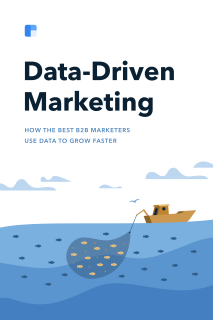Chapter 4
37 minutes
Data-Driven PR: The Story You Never Knew You Had

Brian Dema Head of Marketing at JPMorgan Chase & Co.
Public relations comes with some hard truths. No one cares about your company. They care even less about what features you packed into version 2.1 of your software. You are not a special butterfly.
The nature of today’s media industry hasn’t made it any easier. There are fewer journalists covering more publications, more spin and fake news, and attention spans have only gotten shorter. The majority of journalists or publication editors will never open your email, let alone give you an interview.
This is why more than a few companies have been burned by public relations firms that got them nothing, or spent too much on hipster marketing agency types who use words like “brand essence.” That’s about as far away from demand generation, sales, and hard numbers as it gets.
Luckily, there is a way out: use data to create news. A PR strategy that puts data at the center of the story can produce media attention that you couldn’t buy if you wanted to. You don’t need a million dollars to do it, or a PR team, or a track record, or any special skills other than a little creativity and a lot of hustle.
The results are worth the effort. Media placements in any of the thousands of publications out there that might fit with your brand, from Forbes to Miniature Donkey Talk Magazine (this exists), can establish credibility and bring leads. Such placements can build premium positioning and shorten sales cycles. This is crucial for tech companies with complex products that require education before any sale can happen.
And the beautiful part is that the data—the key to it all—has been under your nose the whole time.
This chapter will show you how to think about PR and a data-driven way to get it done, drawing from my experiences running a mid-size PR agency in Chicago (Walker Sands Communications), spending time at one of the largest agencies in the world (Golin), building a successful PR program at Cisco across hundreds of reseller partners, and serving as a PR and growth consultant for tech startups.
I’ll discuss three companies that have successfully used data to power their public relations, whether they had stats to start with as a natural consequence of running their business, or whether they had to find them. We’ll hear about hiring automation startup Fountain (formerly OnboardIQ), a payroll processing company called SurePayroll (acquired by Paychex), and a venture capital firm focused on artificial intelligence called Zetta Venture Partners. Smart teams from these companies have netted placements in media outlets like The Wall Street Journal, Fortune, CNN, USA Today, Bloomberg, and more.
Everything you know about PR is probably wrong
Most people simply don’t understand PR. Let’s start with common mistakes that can prevent you from getting media attention, and outline a new mindset so that you can avoid them.
It’s not about you
Public relations (PR) is the process of working with the media and other audiences to promote a company or a product. It is just like selling anything else, but in this case, you are selling ideas to journalists. There is no guarantee that they will write about your business or that you’ll even like what they say, but if they do bite … voila! Free advertising.
In fact, it’s better than advertising: PR lets the trusted media show how great you are, rather than you having to sell yourself.
But let’s get things straight: it’s not about you. Pretty much every company that I meet starts by telling me how great their new product is, when their next release is due, and how wonderful it is going to be. Their baby is the cutest. But unless you are Google, it’s not news. The media has bigger stories to tell. Moreover, how do you expect to get media attention between product launches?
Throw out your press release
Founders usually dream of a press release as some grand announcement that is sure to change the world and get featured on TechCrunch and VentureBeat immediately.
The concept of a press release is simple: use a release to tell the media your news, often through a wire service (an expensive distribution method that basically spams journalists), and hope that they will salivate over it. Songs will be sung and epic poetry written.
Honestly, save your ink. As a communication vehicle, press releases are one-to-many, not customized to the journalists you’re targeting, and by and large, they’re uninteresting. Think about it—why would a journalist want to write the same story that just was sent to a thousand other publications?
(That said, press releases are good for one thing: to quickly tell the who, what, and where of a story. They keep you from having to answer stupid questions at your next interview. But they don’t often answer the question of why a specific journalist should write about you.)
A better way is to email a simple story idea—a paragraph with a quick teaser and a catchy subject line: “Hey Bill, I read your last piece, thought it was great, and here’s an idea that I think will work for your readers …” Copy your release at the bottom of the email, or keep it handy in case the writer wants more, but otherwise you can tear it up. A story idea is personalized to the specific writer that you’re targeting, and doesn’t sound like you spammed everyone west of the Mississippi.
Tune out jargon
When you write to a journalist, you must also use their language, not yours. Nobody wants to hear about your multi-factor authentication, ultra-low latency, model 47B, which was approved by an industry association with a 10-letter acronym. They just want a story their readers can understand.
Connect to the world
I was taught to think of the PR process as a wheel with spokes. At the center is the one thing that you want people to know about your company, the one thing that is truly important. This is the reason that anyone should give a damn. This is your brand.
That’s where your story starts.
But to attract media attention, you must express that story in a way that connects to trends and happenings outside of your firm—these are the spokes emanating from the center of the wheel.
Connect your story to the outside world, to something bigger than your company, to a topic that people are already writing about. A movement, a holiday, a happening. Plug into the Zeitgeist.
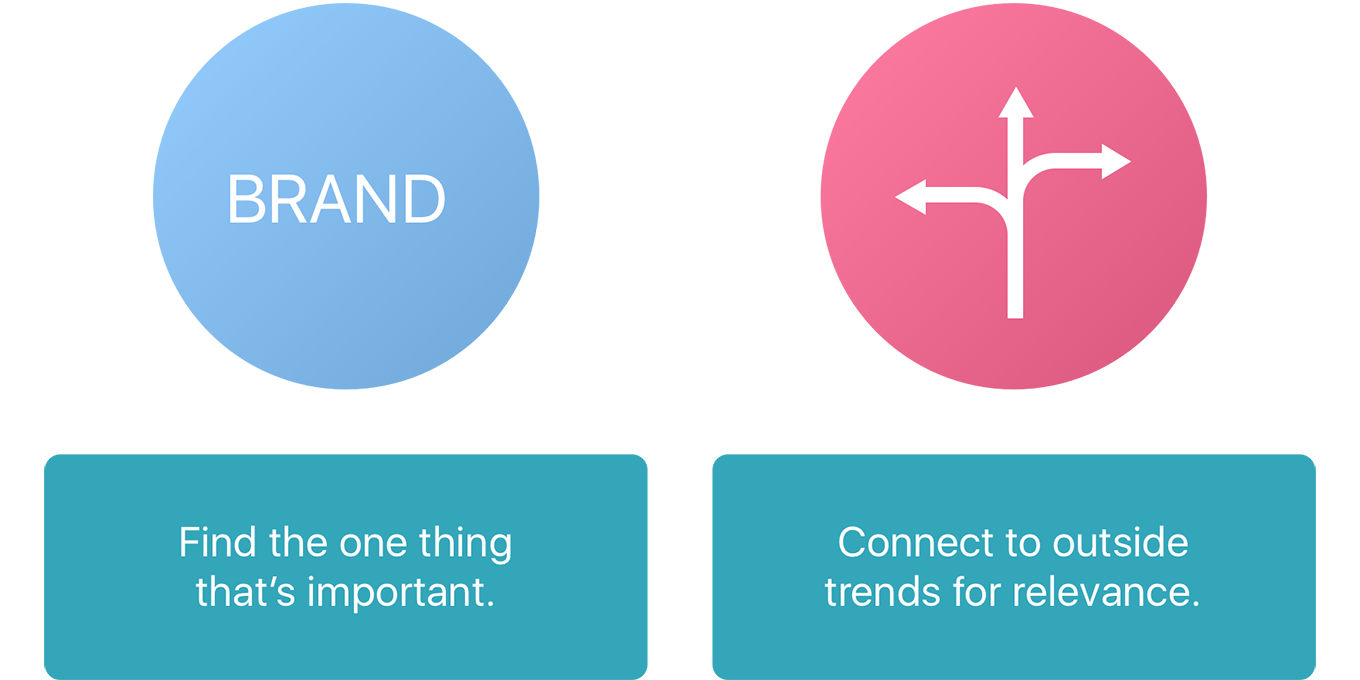
There are many ways to do this:
- Comment on current news (sometimes called trend-jacking)
- Band together with other firms to tell an industry-wide story
- Submit for awards and speaking opportunities
- Create original content and give it to the media
- Piggyback off events that provide a time-sensitive reason for journalists to write today
- Compare yourself to a bigger company that people do care about
To find your topic, do an audit: What conversations are getting picked up? What can you add that is truly new?
In other words, think ahead to what a reporter would be writing about anyway. Then give her a new way to write it.
Segment the media
Your story not only needs to be interesting to the outside world, it also needs to be interesting to the specific journalist that will be writing about it. Find out the writer’s beat. If she is a tech journalist, give her a tech angle. If you’ve got a financial story, don’t pitch it to the celebrity buzz columnist. This is segmentation, as in any area of marketing.
You can segment by type of publication (a tech blog is not the same as The Financial Times), by medium (different stories work for TV than for print), and by industry (e.g., the general business press versus a technical industry newsletter). In other words, when pitching Miniature Donkey Talk, you probably want to include a photo of a donkey.
You can also use time for segmentation. Know when the next edition will come out and work backward to give writers time to put together a story. A daily talk show has a different rhythm than a quarterly magazine. Media outlets often publish editorial calendars, which reveal the topics they’ll write about in the future, so you can plan ahead.
Most importantly, however, segment by geography. Color your story with a local statistic or a nearby example. Most media outlets are still local, and a story with a local angle will win every time. By localizing a story, you may be able to get multiple publications in different regions to write about you at the same time.
Write it for them
Once you’ve found your story, either a PR firm can pitch it to journalists for you, or you can reach out to the media yourself. Agencies use database services like Cision and Gorkana that list the name, email, and interests of every blogger, producer, and newscaster in the world. But you can build your own media list: see who’s writing on your topic, then use LinkedIn, Google, and Twitter to find them. Clearbit Connect can help you find the right email.
From there, it’s all hustle. Well, hustle and packaging. Do everything you can to package up that story so that it will take a journalist no longer than 20 minutes to write it. Make it as easy as possible. Give them high-resolution photos, logos, quotes; these are the components of a media kit.
Look for other ways to help the story along. Research statistics, give journalists access to your customers, find other experts to comment, and be available for interviews right away.
If you’re up for it, you can even write the thing yourself. This is called contributed content, and it’s one of the most effective ways to get media play.
Use data to create news
Segmentation and targeting specific journalists gets you in the door, connecting to trends makes your story interesting to a broad audience, and packaging it correctly makes it easy to write.
Data is how you make news when you might not otherwise have it.
Publish new data about a story, and you’ll quickly become part of it. Data gives context to the story. It adds objectivity and gravitas, which is important if you are a small startup and nobody knows you yet.
One way to create data is to run a survey. Big companies do this all the time. A few years back, I helped Cisco promote a massive B2B study that surveyed 7,500 businesses in 12 economies around the world to quantify the impact of the Internet of Things.
But not everyone has that kind of dough—and it’s not needed. There are cheap or free ways to get compelling data.
Companies are often sitting on data created through the course of running their business, which they can anonymize and package up for journalists. Or, they can simply hunt down data that others have published, add commentary, and create an easy reference for reporters.
To recap our data-driven PR approach:

All three of the stories that I’ll share show companies that have used data to get press attention, and you’ll get an inside look at how they pulled off these clever PR campaigns. Let’s look at how Fountain used a healthy dose of data to win far-reaching coverage. Not to spoil the ending, but they came to be seen as experts in their field, and raised a Series A round within a year.
PR on demand: How Fountain became experts in hiring
Keith Ryu knew that we needed to expand our market if we were going to raise our Series A. He had to find a way to sell to large companies; after all, our hiring automation software was designed to help companies hire contract workers quickly and by the thousands. Our company, on the other hand, consisted of 12 people.
We’d need to look bigger than that if we hoped to swim with the big fish.
Keith Ryu is the CEO of Fountain (formerly OnboardIQ), and the firm’s hiring automation software was helping to drive the wave of new on-demand businesses delivering everything from lunch to marijuana. GrubHub, Caviar, Managed by Q, Cabify, and Deliveroo have all been clients. The sector was growing, but nothing lasts forever.
We planned to approach new industries like retail and hospitality, which were worlds away from the tech firms of San Francisco that we knew. More than that, the team at Fountain would need to be seen as thought leaders in hiring, not just people who could write code.
I joined Fountain as a marketing consultant, and as a part of building our marketing efforts, I turned to public relations to help us grow. Fountain may have been just a dozen people in a room, but it had a great story to tell. It also had unique data with which to tell it.
Our software had processed millions of job applications and hundreds of thousands of hires, and the team had big plans for the mountains of data that it was collecting. We were already starting to predict things like interview no-show rates or how long it might take to hire top candidates. We could use machine learning to analyze hiring behaviors to help companies identify successful candidates early in the hiring process. Data could help businesses hire while getting people in the gig economy back to work.
“The question for us was how to package the unique insights that only our company has access to,” says Keith. “We processed it to make better product decisions, but we also thought about how we could package it to give to the wider world, especially in the area of contract hiring, where there is not a lot of information or benchmarking available.”
Even the US Labor Department doesn’t track contract workers regularly; Fountain could. We had numbers on hiring, job applications, the average time it takes to make a hire, etc. This was telling about our clients, of course, but also about the gig economy and the growing on-demand sector. Not all of our clients were on-demand companies, but it was a hot industry that everyone was talking about.
“We realized that we are one of the only companies to have a holistic view of the industry,” says Keith.
The best part was that we’d collected this data through the natural course of running the business; there would be no surveys or expensive market research, and it wouldn’t take our engineers hours to get it together.
This was the PR platform that we were searching for.
So, we got to work. We chose a cohort of on-demand clients for which we had solid data (22 firms with nearly 250,000 job applications for the year). There was a lot of gut-checking involved; we tossed the outliers and whittled our sample down until we felt confident in the numbers, but we kept it to a size that was impressive and represented a significant slice of the industry.
We aggregated and anonymized the data to protect our customers. We tried to find a way to tell a story with it, looking at changes over time, highs and lows, regional differences. We found interesting correlations, and some new questions:
- Monthly hires had doubled throughout 2016 for our on-demand clients, although job applications had actually decreased. Were applicants getting more selective? Was the pool of applicants narrowing?
- By October, the time that it took to make a hire was half that of January. Were companies getting less picky?
- We looked at year-over-year numbers and saw that while on-demand firms were surely growing, the rate of that growth had slowed. Was this a warning sign for the industry? Or were these companies simply maturing?
We didn’t need all the answers, just good questions.
But we did want to provide our perspective, so instead of just sending interesting stats to the media (a technique that could have definitely gotten results in the short term), we wrote an economic report on the industry.
Enter The OnboardIQ On-Demand Jobs Report.
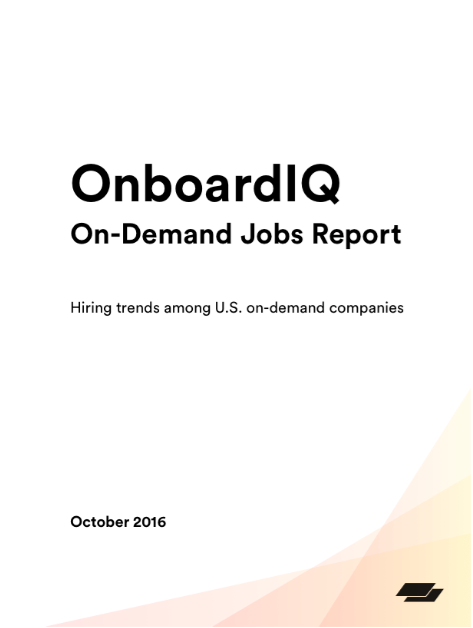
This thing was a beast: 12 pages with a dozen charts, and the look of something that you’d read at business school. We let our customers weigh in, including quotes from clients like Groupon To Go. We also included a breakdown of Silicon Valley firms, which gave us a regional angle.

A chart and takeaway about the overall decrease in on-demand hiring time. The bottom-right corner features a quote from Chad La Tourette of Tapingo, an on-demand client of OnboardIQ/Fountain.
In addition, we included external stats on the industry—like consumer spending and the percentage of the American workforce involved in contract labor, referencing the Harvard Business Review and studies by Deloitte. This gave us context. It also made Fountain look a lot more established than our faded hoodies might have let on.
We even compared our results to employment statistics from the US government, and timed our launch to match the October release. This made it topical. This made it news.
We began promoting the report to the media, reaching out to key journalists and having a small PR firm promote it to their contacts. We shared the report on social media—the visual nature of all the charts and graphs was a perfect fit. We published on SlideShare. We even advertised the report through promoted posts on LinkedIn—ads which had by far our highest conversion and click-through rates.
Within days, the results started coming in. Fountain found itself in the lead story on the Fortune Term Sheet discussing growth in the gig economy. The report was picked up by Yahoo Finance, Website Magazine, and newsletters from FundersClub and SoftTech VC. Fountain co-founder Jeremy Cai even appeared on Cheddar TV.
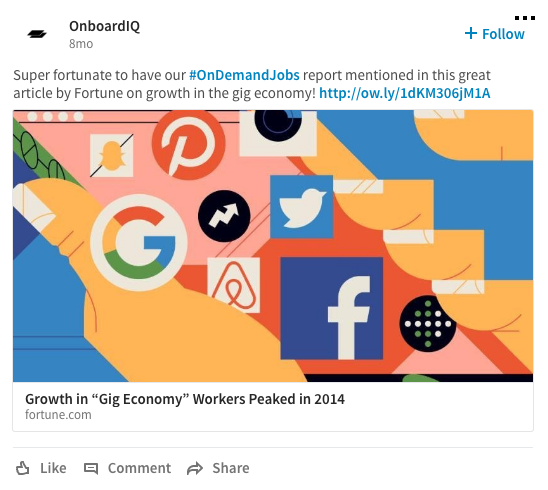
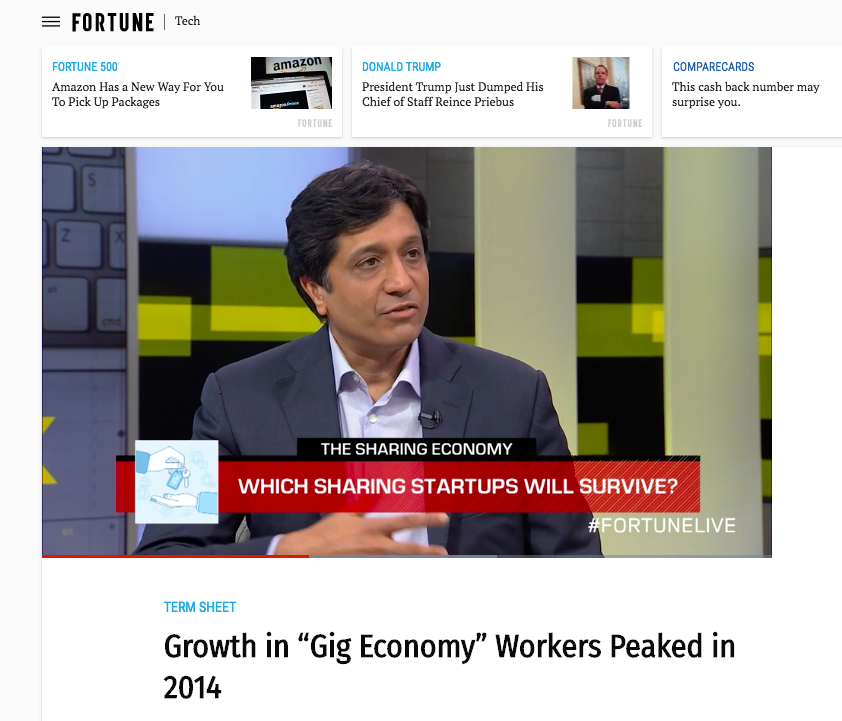
We used the attention to get real customer leads. We created a microsite for the report as a place to send interested media and prospects. This site showed the highlights of our findings and our best charts, and it included contact information and downloadable media assets. We collected email addresses when people downloaded the full report.
For the first time—in my PR career, anyway—I was able to see exactly who was interested in our story. The answer was over 130 people, including prospects, analysts, consulting firms, and nearly two dozen venture capital firms (at least one of which would later invest in the firm).
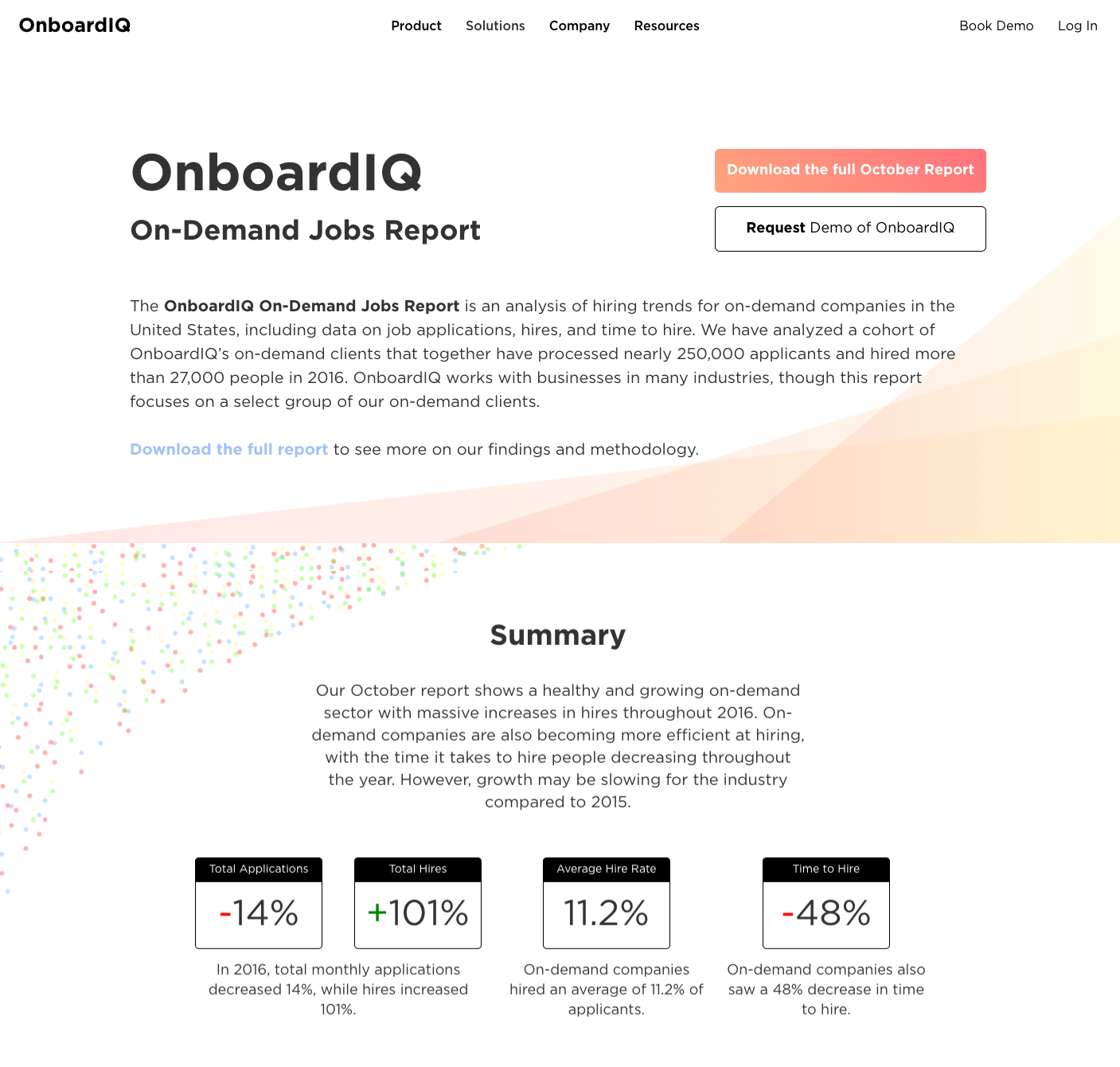
Pictured here is a section of the On-Demand Jobs Report microsite, which email-gated the full report. The full microsite, onboardiq.com/jobs_report, includes summary statistics and highlights.
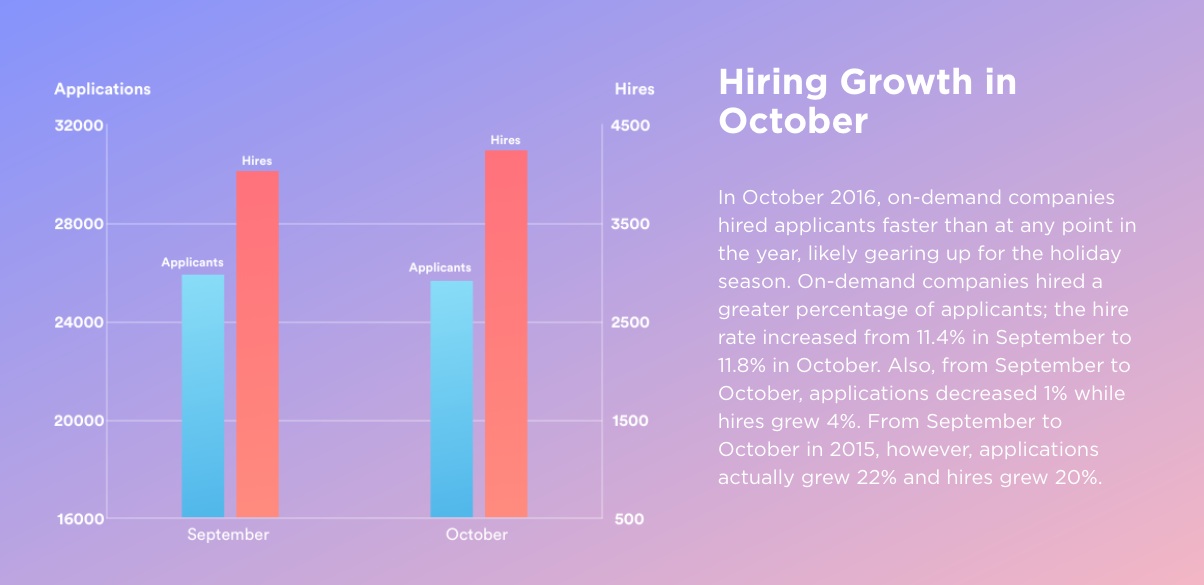
The microsite includes snapshots of compelling statistics and takeaways that tease the contents of the full report.

Pro tip: Always help reporters with downloadable assets like images, logos, and bios. Here’s the Media Resources section of the microsite.
The On-Demand Jobs Report allowed us to not only start a conversation, but also to fundamentally change how we spoke as a firm. Suddenly, we were no longer a startup selling software; we were experts commenting on an industry.
This came to a head weeks later when our little team was asked to present about on-demand hiring best practices at Walmart. Yes, Walmart. The largest company in the world. Not only had Walmart recently acquired Jet.com, but it was also considering offering delivery and other new models at some of its stores.
After the article in Fortune, it wasn’t hard to show that we knew about contract hiring. We didn’t know it then, but our Series A funding would come by the summer, along with a major hiring push for Fountain itself.
Good thing that we were the experts.
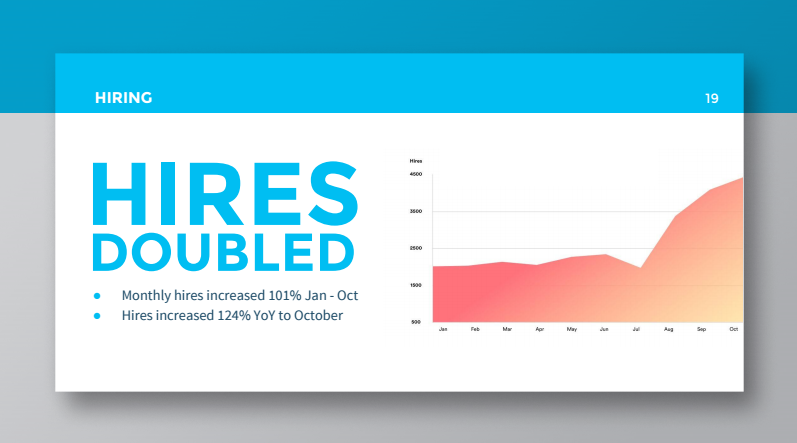
Our presentation to Walmart summarized top statistics and gave our advice. See a reduced version of that presentation here.
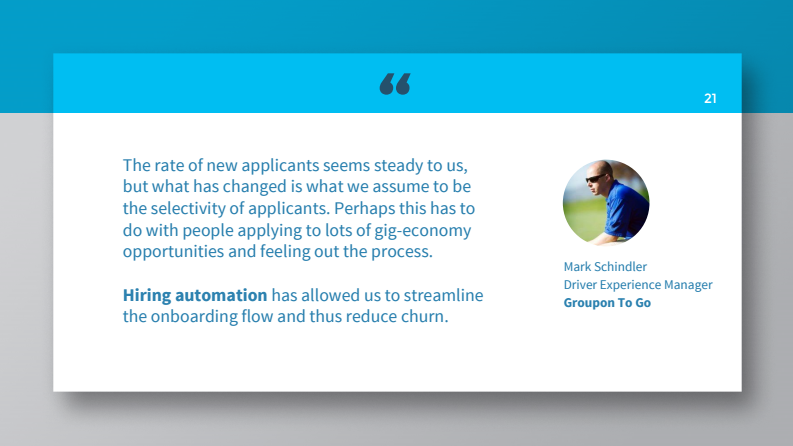
We made sure to work in quotes from on-demand clients, such as this one from Mark Schindler of Groupon To Go.
Takeaways
The Fountain example shows why data can be the perfect platform for stories. It’s objective; no one could question data on nearly 250,000 job applicants, even though our company was small. It can be timed with periodic reports or events. It can be differentiating, providing something to the media that they can get nowhere else.
If you do it right, data-driven PR is also repeatable. Fountain could have published a new report every month. By refreshing the numbers, you can get consistent media attention over time, not just when you have a launch or some huge news.
We are also beginning to see a paradigm for how to use data for PR.
- Get the data: You may have data as a side effect of running your business. If you don’t, find it through external research.
- Ask why: Build a story behind the data. Connect it to an outside trend.
- Distill it: Boil it down to just one or two stats that hit you over the head, and share it with journalists to introduce your story.
- Package it for the media: Do everything you can to make it easy to write your story. Serve research on a platter. Segment by geography, time, and beat to customize your pitch to individual journalists.
- Make it a part of your business: PR will result in more than just eyeballs if you integrate your marketing strategies together. Use your newfound data in content marketing and advertising, and utilize downloadable reports to capture leads.
Our next example, SurePayroll, takes repeatable PR to the extreme with a report that has produced media results for over a decade.
Even the score: How SurePayroll changed the game
Ken Gaebler met Michael Alter, the CEO of SurePayroll, for lunch in early 2002. Ken had recently founded Walker Sands Communications, a tech-focused PR agency in Chicago. It was the early days, when the firm was in an office near a fish market, a far cry from the glass skyscraper overlooking Millennium Park where it is today.
Ken had been through the heady dot-com days, raising over $20 million for BeautyJungle.com, which Fortune once rated as the #4 e-commerce firm (Amazon was #3). He had sold a data visualization software company called VREAM, and consulted for Andersen and McKinsey. He was no stranger to change.
SurePayroll processes payroll for small businesses, and it faced stiff competition from established players in the space. As Michael told Ken: “Right now, when people think about payroll providers, they think ADP and Paychex. Instead, I want them to think ADP, Paychex, and SurePayroll—as long as we are in the mix, I know we can get the business.”
If Ken was going to help SurePayroll get in the game, he needed to build its presence in the media. But first, he needed journalists to take his call. Payroll processing is not exactly the most glamorous business, and SurePayroll was the new kid in town.
What SurePayroll did have, however, was information. SurePayroll knew about the intricate workings of thousands of small businesses across the US; after all, it wrote their checks. Ken realized that this was the way to connect SurePayroll to something bigger than payroll: trends in small business.
As Ken tells it, “We mined SurePayroll’s data to test the idea that we could use payroll data to create media-friendly statistics that would help us get more visibility. To test the theory, we pulled statistics that showed how small businesses were becoming increasingly reliant on 1099 workers. That led to our first data-driven PR placement in late January: a story entitled A New Kind of Workforce Emerges that ran in the Washington Post. Reuters picked it up as well, resulting in dozens of media placements. At that point, we knew we were onto something.”
Ken and the team at Walker Sands put together what would become known as the SurePayroll Small Business Scorecard, using the firm’s payroll data as an indicator of the broader small business economy. It was data that the media could get nowhere else, focused on small businesses and constantly updated. In aggregate, it told stories about risk-taking and entrepreneurship.
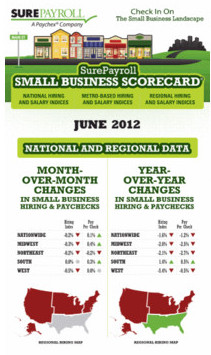
A June 2012 Scorecard. The design has changed, but the strategy continues to produce.

The footer of the December 2016 Scorecard reads: “SurePayroll’s Scorecard compiles data from small businesses nationwide, and exclusively reflects the trends affecting the nation’s “microbusinesses”—those with 1–10 employees. The average business reflected has 6 employees.”
The first edition of the SurePayroll Small Business Scorecard discussed how the small business economy had fared in the first quarter of 2004. To make it real, Ken boiled the numbers down to just a couple of juicy stats. For example: hiring is down, but salaries are up by X%. These quotable stats make the perfect sound bites for an article about the economy or a related business topic.
Taking it a step further, Ken localized the story, creating breakdowns for each state and major city. “Use segmentation of your data to tell your story to distinct target audiences,” says Ken.
“For example, if your data can be filtered by geography, you might want to not only publish national statistics, but also publish statistics at the city level. This increases placement yield because there are many more journalists who cover local stories than national stories. Similarly, you might be able to segment your statistics by industry, by profession, by whatever makes sense—you have to be creative.”
The broad applicability of this method means that it can produce potentially hundreds of media mentions at once.
One key in making this happen is to automate the process, not only of gathering the data, but also of promoting it. “Automate the data storytelling,” as Ken puts it. For SurePayroll, that meant coupling the data with Excel formulas to write sentences in English to explain the local story for each region. Otherwise, the process would have been tedious and the output less compelling.
The report was also timed for maximum impact, released monthly to coincide with reports on employment growth by the Bureau of Labor Statistics. Many journalists cover this news and write about it each month. The Scorecard gave them something new to say, a twist, and context to bolster their interpretation of the high-level numbers.
For SurePayroll, this virtually guaranteed dozens of media placements every month. Reporters would reference the report, call for more details, and end up quoting Michael Alter. Many times they’d end up writing about SurePayroll itself.
The result: hundreds of placements, perhaps even thousands, including names like The Wall Street Journal, USA Today, Bloomberg TV, PC Magazine, Inc. Magazine, Entrepreneur Magazine, MSNBC, Investor’s Business Daily, Fortune, CNET, Businessweek, CNN/Money, U.S. News & World Report, and trade publications like Accounting Technology, Practical Accountant, and Bank Technology News. Many of these placements linked to SurePayroll’s website, bringing traffic and helping to fuel new leads.
The media weren’t the only readers of the Scorecard. Public officials even started to reference the findings, using the statistics to advocate for various policies and new regulations. I remember a state governor once quoting the Scorecard in a speech.
SurePayroll’s competitors took note as well. “After we had been getting tons of media coverage for over two years,” says Ken, “SurePayroll’s largest competitor, ADP, decided that they wanted in on the action. They launched the ADP National Employment Report in May 2006. ADP had a big advantage over SurePayroll in that their customer base was much larger and they were not limited to focusing only on small businesses.”
It’s not uncommon for successful PR moves to be copied by competitors. You need to come up with the next angle to stay ahead (but at least you know that you did something worth stealing).
Over time, Ken and the team would add more to the report, bolstering it with new statistics and surveys of SurePayroll’s small business clients. They might ask about optimism toward the current business climate or their take on upcoming elections. “When the data you have isn’t getting the job done and you’re not seeing enough media pick-up, one way to bolster your pitches is to augment the data-driven stats with surveys of people in your industry to see whether they agree or disagree with your findings,” says Ken. “You can survey them on just about anything, for that matter.”
Ken ended up using a range of PR tactics, including contributed content, creating bylines for Michael Alter in trade publication articles. “Another tried-and-true trick is to partner with an expert to increase the credibility of your statistics. For example, you might contact a local university to see if they might co-author your report,” says Ken.
The Scorecard ran for years—14 years, in fact. And it’s still going.
ADP is still putting out its own report as well. But that didn’t stop SurePayroll. During the seven years that Walker Sands provided PR, SEO, and other marketing services to SurePayroll, the company’s annual revenues grew over 1500% (15x) and the customer base grew to over 30,000 small businesses nationwide. For multiple years, SurePayroll earned a spot on the Inc. 500 list for fast-growth companies.
Paychex acquired SurePayroll for $115 million in 2010.
Today, Walker Sands is an agency of nearly 80 people and has many clients. Ken still teaches them how to use their data, though his office now has a view of Lake Michigan, not snow melting on the “L” tracks.
Michael Alter has moved on too. He’s now an Entrepreneur in Residence at the University of Chicago Booth School of Business, doing some teaching of his own.
Takeaways
With the SurePayroll Scorecard, we can add a new element to data-driven PR: repetition.
Once you find the data, build context around it, distill it to its most powerful soundbites (remember, soundbites become headlines), and package them for the media—and now you are ready to hit repeat.
Find ways to produce consistent data month by month or quarter by quarter. It will become easy to produce and can take on a life of its own. There could be a year-end round-up, a special report for the holidays, the lovers’ survey for Valentine’s Day, or a tongue-in-cheek version for April Fool’s Day. Just keep it fresh.
You must also work to turn that media attention into new business. This could include republishing media wins on social media, or using paid social advertising or distribution services like Outbrain to promote them.
Use your newfound notoriety as an industry expert to obtain speaking opportunities or to publish your own content. As Ken says, “Think about how the data will support your business and marketing objectives. While it’s great to get your brand mentioned in the media, it’s even better if the people who see your brand then get in touch and enter into your sales and marketing pipeline.”
For our last example, we turn to Zetta Venture Partners to answer the question of what to do when you don’t have data—at least not any created through the course of running your business. Never fear; our method still works. You can always find the data you need.
In fact, we were able to find data that got media attention for both Zetta and its portfolio companies.
Venture PR: How Zetta Venture Partners turned the automation debate on its head
Ash Fontana and I met at his office above the designer retail shops near Union Square in San Francisco. Ash is a Managing Director at Zetta Venture Partners, a venture capital firm, along with Mark Gorenberg and Jocelyn Goldfein. I was introduced to him through someone at Walker Sands Communications, which had recently expanded to San Francisco.
Zetta invests in artificial intelligence (AI) companies, particularly in software built for enterprise applications. We talked about machine learning, analytics, and intelligent software. I would soon learn words like data moat, reinforcement learning, and computer vision.
Ash and I met in early February 2017, several months after Zetta had closed its second fund (Zetta now has $185M under management). In many ways, Zetta is exemplary of a new wave of VCs with a distinct model: focus on one sector, provide deep advice, and write checks for classic Series A–style investments, not the later-stage deals that have attracted some established VCs. True growth capital.
The strategy has worked: Zetta has already invested in multiple unicorns (InsideSales.com and Domo).
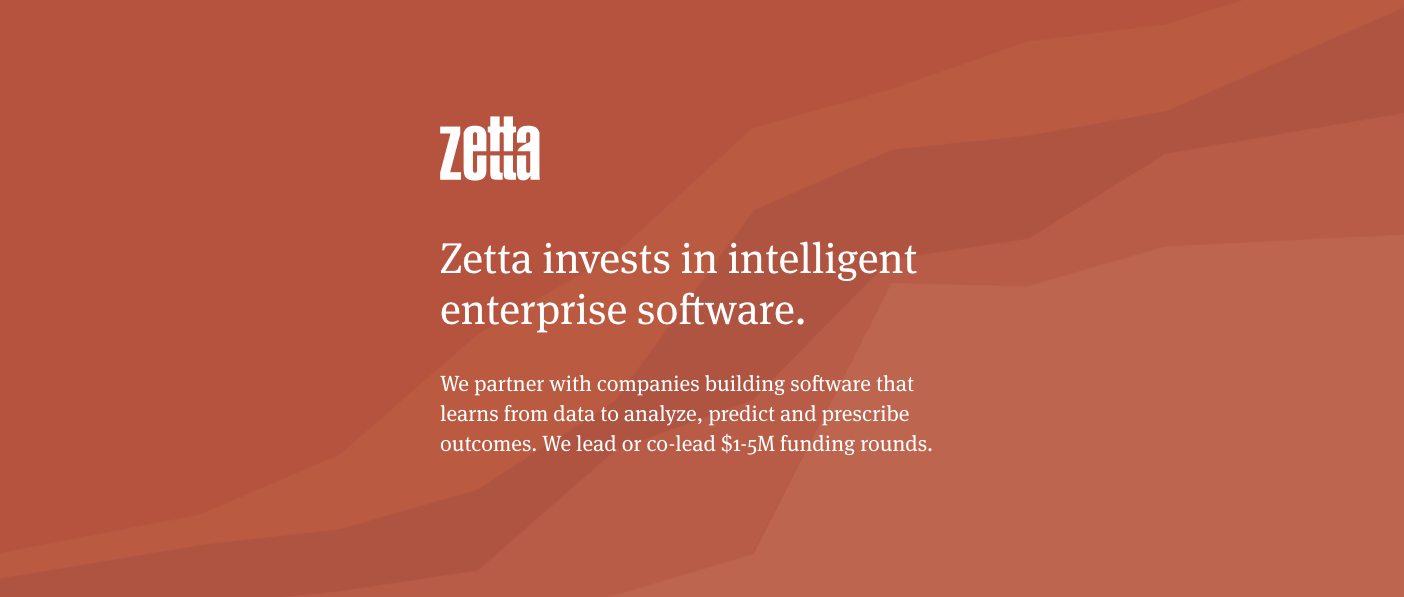
“We think AI will affect every industry,” Ash told Forbes in October. “It’s a fundamental shift in computing.” Zetta works with companies applying AI to everything from manufacturing (Falkonry) to insurance (Tractable) to retail (Dor), including a certain data augmentation startup called Clearbit using machine learning to make sense of public data sources.
In other words, Zetta likes companies built on data.
Zetta was, in fact, the first institutional fund focused on AI. But this distinction wouldn’t last forever. With a limited window before other funds would pounce on the space, Ash wanted to build the Zetta brand so that they could stay out front.
While I was new to AI, I had seen a similar PR challenge before.
Like all VCs, and especially newer funds, Zetta needed to differentiate itself to gain access to investors for fundraising and to early-stage startups for deal flow. The growing hype around AI, not to mention general confusion around what it even means, didn’t make things easier.
Partners at venture firms need to build their personal brands as well, both for credibility and to build a network so that they get the call when the right founder is ready to raise. Promoting the Zetta team as experts on AI, startups, and investing would be crucial.
Just as important as marketing the firm, however, was gaining visibility for its portfolio of startups. Zetta’s success rested on the backs of these young firms, and the team wanted to help them in every way possible. Promoting Zetta’s portfolio would also help secure its place at the center of the ecosystem.
I often met these startups right before we announced Zetta’s investment in them. But the results from funding announcements are hard to predict. While $5M is a lot of money to a startup, it is not to The Wall Street Journal. Additionally, the time-sensitive nature of these releases, involving embargos with the media until specific dates and potentially multiple VCs, makes them tricky.
Like any good PR, we’d still need to connect these raises to a bigger story. That story had to be broader than any one startup, and bigger than Zetta itself. Borrowing a page from the Fountain and SurePayroll playbook, we discussed creating a data-fueled report of Zetta’s own. But where to find the data? Zetta didn’t have thousands of traditional clients or operational numbers that we could summarize.
Zetta’s problem wasn’t all that different from the average AI startup. In order to train their computer models, they need massive amounts of data—but where to get it? “We often talk about a virtuous loop of data,” says Ash, “using active learning and an architecture that constantly feeds the data created through your business operations into machine learning algorithms, producing better insights and thus generating even more useful data.”
We realized that Zetta’s unique position in the industry was the ticket. Who better to comment on the latest in AI than the premier fund investing in it? After all, Zetta did work with dozens of companies in the space. This type of thought leadership would position Ash, Mark, and Jocelyn as experts, and hopefully spur startups to come for advice.
But we couldn’t just talk about Zetta’s take on the AI industry; the average reader doesn’t understand AI. We needed to connect the Zetta story to something that everyone does understand. Otherwise, the best that we could hope for were technical stories in niche publications.
Our answer: jobs. Good old jobs.
The job debate was already well-connected with AI—everyone was talking about how automation would destroy jobs. Computers would take over the world, and take our jobs with it. In fact, a solid percentage of all articles on AI were about the potential jobs that would be lost.
We had tapped into something divisive. At an MIT conference on AI sponsored by Zetta, Hemant Taneja from General Catalyst talked about “algorithmic accountability” and even how we may need to find new purpose in our lives in a future without work.
Since everyone was talking about job destruction, we turned the conversation on its head and decided to discuss how AI could create jobs. We needed a new angle to stay above the fray, and to give writers a good reason to put time into yet another piece on automation. Our take was that many applications of AI augment human labor rather than replace it, while the boom in AI startups would directly create new jobs.
As we created our pitch, we collected examples from Zetta startups to bring it home (and to promote the portfolio!). Falkonry combined industrial automation with the knowledge of domain experts to create the “smart factories” of the future; Lilt found a way to incorporate expert human input into machine language translation while its system actually adapts to human feedback.
We gave the Zetta perspective on how to build a successful AI startup. We also listed examples of non-portfolio companies that were creating jobs through AI. For example, Samasource has created jobs for 8,000+ people in the developing world to help tune machine learning systems. It’s an AI-focused business that is lifting people out of poverty.
I researched every industry report and academic study that I could find on the correlation between automation and jobs. I found studies from Oxford and PwC, with some economists saying that automation would replace 47% of jobs, and a few that said the number of jobs would actually increase. These stats would not only provide context for our take on the debate, but also do half of the journalist’s work for her—she could write a well-informed story citing many sources in 10 minutes.
As I wrote in a portion of our actual pitch to the media:
Here’s a different take on the job automation debate for you ... Everyone is talking about automation these days and it’s real: PwC, McKinsey and the NBER all just put out research on how artificial intelligence is changing the future of work. Bill Gates has called for a robot tax. Papers from Oxford and the OECD have estimates ranging from 9% to 47% of employment at risk of automation, while economists like James Bessen think that partial automation will actually increase employment.
Whatever the future may be, it is obvious that learning algorithms are changing our lives. Much has been said about how the AI programs of giants like Amazon, Microsoft, and Google are destroying jobs. What hasn’t been discussed, however, is how innovative startups are using AI to create jobs and combat job automation.
Zetta Venture Partners is a venture capital firm that invests in startups using AI. In fact, we were the first fund purely focused on AI for the Enterprise, and our founders have been investing in analytics for the last 25 years. Many of our startups are using AI in ways that augment and create jobs, and are growing fast and scaling as companies in their own right …
I’d love to work with you on a story about the positive side of AI—job creation, rather than just automation …
The rest of the pitch laid out other helpful information for the journalist, including several Zetta portfolio companies as examples and Zetta’s list of tips for AI startups. We also localized it for each of nine different cities or regions (Silicon Valley, LA, Chicago, NYC, Boston, Austin, Utah, the Pacific Northwest, and the South), using CB Insights to find interesting local AI startups to bolster our theory.
In addition, we wrote custom versions of the pitch for each of the Zetta partners. Each partner worked more closely with certain portfolio companies, so a custom pitch could feature those examples and specific quotes from that partner.
By abstracting the story away from the technical side of AI, from any specific startup, and even away from Zetta itself, we were able to attract the media’s attention. At the same time, we shifted the conversation to focus on Zetta’s advice and expertise.
Placements began to appear. Xconomy Boston wrote a piece on Mark Gorenberg titled “Amid Automation Debate, A.I. Backers Tout Job Creation Potential.” As Mark told Xconomy, “Our take is, net, it’s going to be positive for society and positive for the human condition. I don’t think we should fear these technologies.” He even predicted that the term artificial intelligence would go away as machine learning and related technologies become ubiquitous in software.
Ash found himself quoted in Inc. Magazine and the San Francisco Chronicle, and had a long investor profile piece written in Silicon Valley Business Journal. These stories were not all about job automation, or even AI. That broader jobs storyline simply gave us a reason to reach out and a reason for the journalists to take us seriously.
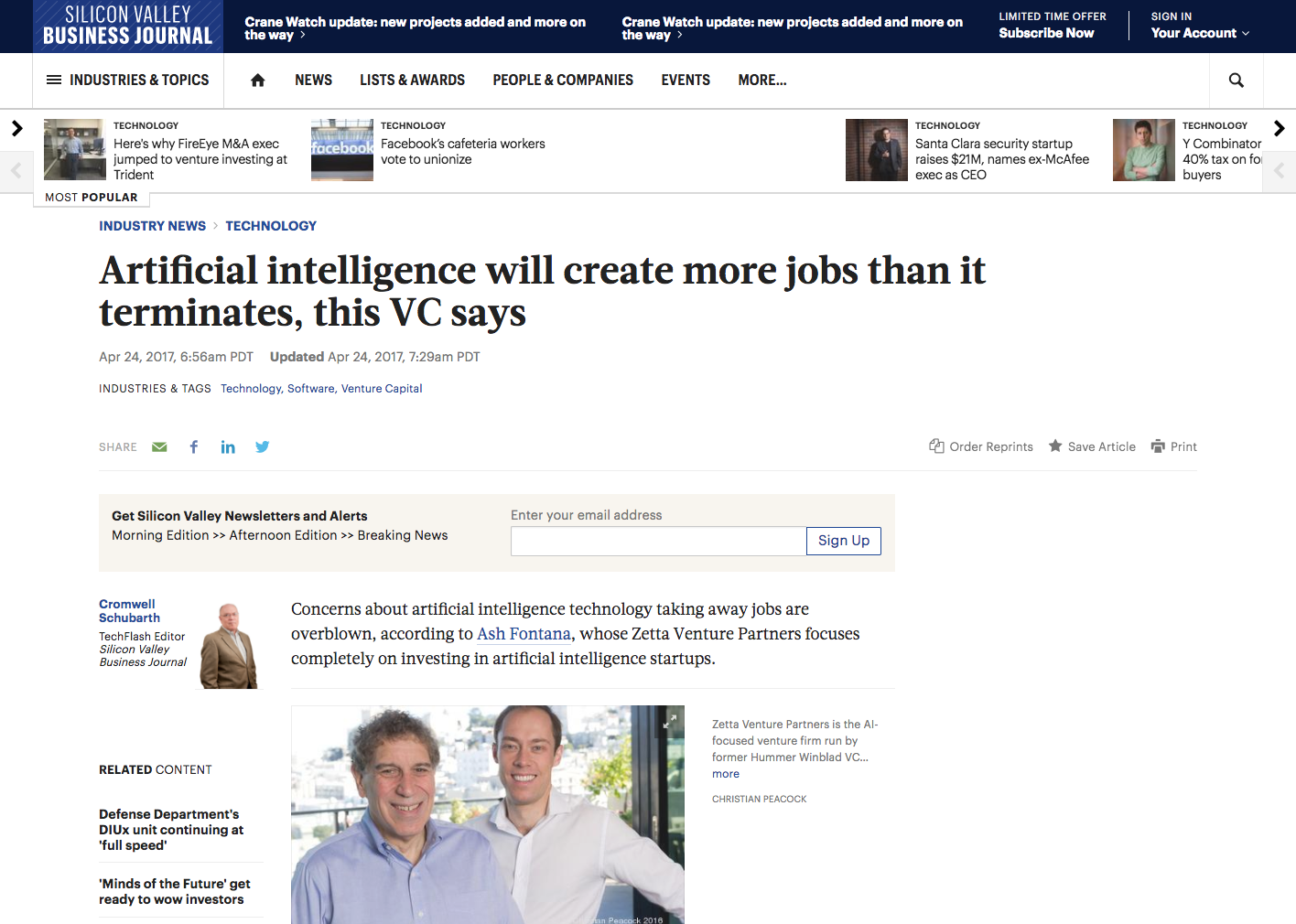
Zetta’s feature in Silicon Valley Business Journal
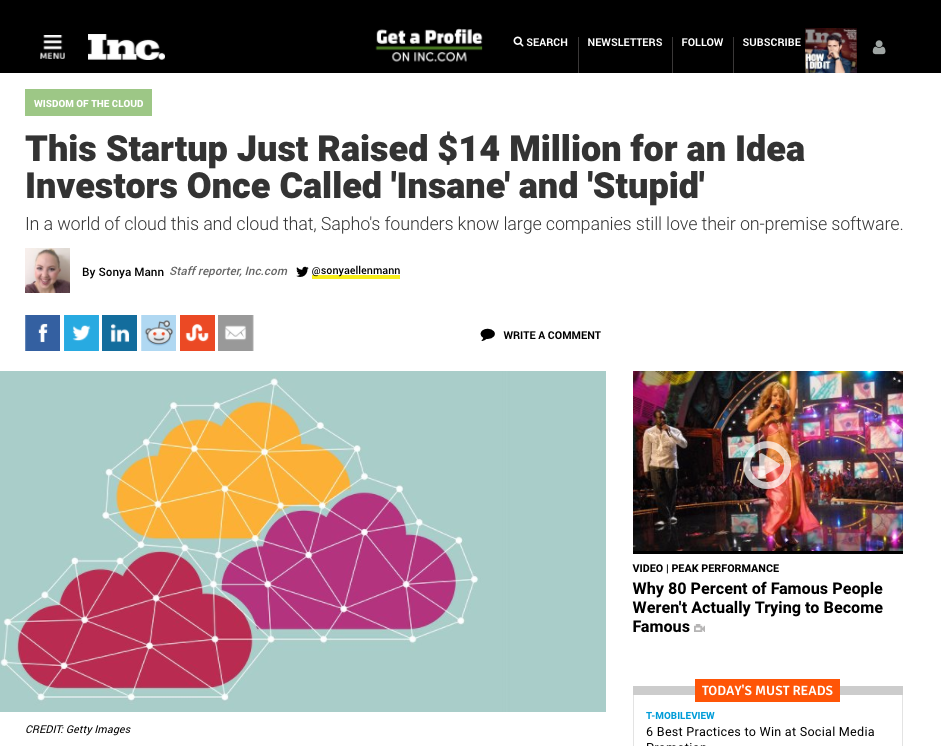
Ash was quoted in this Inc. piece centered on another startup, showing that you can engage with the media and promote your expertise even when your company is not the centerpiece of the story.
The relationships built through this PR push have since netted not only other placements for Zetta, but also for its portfolio companies. One startup, Tractable, has recently talked to some of the same journalists about AI-related job creation in the insurance sector.
What’s next for Zetta? They’ve been considering how AI will change the face of cities, particularly due to autonomous vehicles—another hot topic filled with data.
Takeaways
We can learn a few things from Zetta’s data-driven PR approach. First, to avoid being limited to niche publications, Zetta connected AI to a broadly relatable topic: jobs.
Second, if you aren’t sitting on proprietary data and don’t have the time or money to run large surveys, you can collect external statistics. These will give context to any story. At the very least, this will save journalists time and make them more likely to pick your story over the dozens of others that they get pitched each day.
Third: localize. Zetta personalized its pitches by including examples of AI startups in each city that it pitched.
Lastly, PR is a long game. It can build momentum, cadence, and a history for your business over time, not just make a splash when you first launch. You don’t even need to be the centerpiece of the story. Tight relationships with the media can produce coverage for years to come. In Zetta’s case, these relationships even helped its portfolio firms.
Your path to better PR
As you consider using data for your startup, follow the examples of SurePayroll, Fountain, and Zetta Venture Partners. They didn’t have large teams of PR professionals or big budgets, but they made up for it with deep thinking. In return, they had the ear of journalists and positioned themselves as experts in top media outlets.
To recap the approach:
Find data through the operations of your business or out in the world through surveys, industry statistics, or expert commentary. Ask yourself why it’s important, what deeper trends might be linked, and how this strategy can fit with your business goals. Dig, distill, and slice until you’ve reduced the story to its core, and present the data in the simplest way possible.
Segment the data, breaking it down by geography or industry. Make it local! Or, build a story across your industry by partnering with other firms. Time the release of your story in concert with events, holidays, or external reports for maximum impact.
Package it for the media—find experts, write quotes, send materials, put together everything to help a journalist write a story fast. Send out your pitch via customized story ideas based on the interests of each journalist.
Refresh your data periodically. Wash, rinse, repeat! Try to automate the process along the way. And make sure to find a home for your PR data online on a microsite, blog post, or downloadable report to extend its shelf life. Integrate it with the rest of your marketing plan, and find ways to drive leads back to your business and to capture them.
In the end, all PR is about a story. Hopefully, it is one that people want to read and that a journalist wants to write. Let data find the story behind your business.
Note: The work discussed in this article is separate from my work with Silicon Valley Bank, and does not represent the views of the bank.
